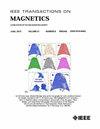Graphics Processing Unit Simulation of Magnetic Domains Under Alternating Field Excitation Including Iron Enhancement
IF 2.1
3区 工程技术
Q3 ENGINEERING, ELECTRICAL & ELECTRONIC
引用次数: 0
Abstract
Predicting the magnetization of ferromagnetic materials in the presence of dc and ac background fields generated by current-carrying windings is a frequent requirement for important engineering applications in electrical machines and electromagnet design. Existing finite element techniques for the estimation of these effects are based on time-consuming, nonlinear iterative solvers. A novel mesh-free technique is proposed to overcome the issues related to coupled domain discretization, which also requires meshing the background media (air domain) of the control volume. In the proposed approach, the ferromagnetic domain is filled with small spherical subvolumes representing the complete magnetic domain. These spherical subvolumes are magnetized by the background magnetic field and their interaction with each other results in the cumulative field enhancing the ferromagnetic effect on the ferromagnetic element. Such an approach to modeling ferromagnetism presents a simple engineering solution that is on par, if not better, than conventional finite element methods. Although these methods do not model boundary effects between microscopic Weiss domains, the proposed method approximates this to a more reasonable extent than conventional finite element methods. Using this approach, the effect of each magnetic sphere can be concurrently calculated on general-purpose graphics processing units (GPUs), reducing computation time compared to by commercial finite element solvers while achieving comparable accuracy in the solution. With more powerful, state-of-the-art GPUs, the proposed mesh-free approach could be used to model complex domains and perform design space exploration of geometric constraints considered impractical with finite element methods. The proposed method is validated by comparing its performance against results obtained using a commercially available finite-element solver for a common iron geometry. This approach constitutes an approximate surrogate model for the fast optimization of complex systems, which would be relatively slow to implement with finite element methods.包括铁增强在内的交变磁场激励下磁畴的图形处理单元仿真
在载流绕组产生的直流和交流背景场中预测铁磁材料的磁化强度是电机和电磁铁设计中重要工程应用的一项频繁要求。现有的用于估计这些影响的有限元技术是基于耗时的非线性迭代求解器。提出了一种新的无网格技术来克服耦合域离散的相关问题,该技术还需要对控制体的背景介质(空气域)进行网格划分。在所提出的方法中,铁磁域由代表完整磁域的小球形子体积填充。这些球形子体被背景磁场磁化,它们之间的相互作用产生了累积场,增强了对铁磁元件的铁磁效应。这种铁磁性建模方法提供了一种简单的工程解决方案,与传统的有限元方法相比,即使不是更好,也是相当的。虽然这些方法没有模拟微观魏斯域之间的边界效应,但所提出的方法比传统的有限元方法更合理地接近了这一点。使用这种方法,可以在通用图形处理单元(gpu)上同时计算每个磁球的影响,与商用有限元求解器相比,减少了计算时间,同时在解决方案中实现了相当的精度。有了更强大的、最先进的gpu,所提出的无网格方法可用于复杂域的建模,并对有限单元方法认为不切实际的几何约束进行设计空间探索。通过将所提出的方法的性能与使用市售的普通铁几何形状的有限元求解器获得的结果进行比较,验证了所提出的方法的有效性。这种方法为复杂系统的快速优化提供了一种近似代理模型,而用有限元方法来实现相对较慢。
本文章由计算机程序翻译,如有差异,请以英文原文为准。
求助全文
约1分钟内获得全文
求助全文
来源期刊

IEEE Transactions on Magnetics
工程技术-工程:电子与电气
CiteScore
4.00
自引率
14.30%
发文量
565
审稿时长
4.1 months
期刊介绍:
Science and technology related to the basic physics and engineering of magnetism, magnetic materials, applied magnetics, magnetic devices, and magnetic data storage. The IEEE Transactions on Magnetics publishes scholarly articles of archival value as well as tutorial expositions and critical reviews of classical subjects and topics of current interest.
 求助内容:
求助内容: 应助结果提醒方式:
应助结果提醒方式:


